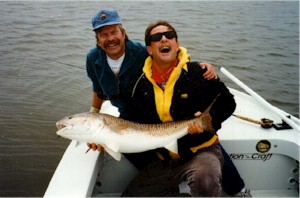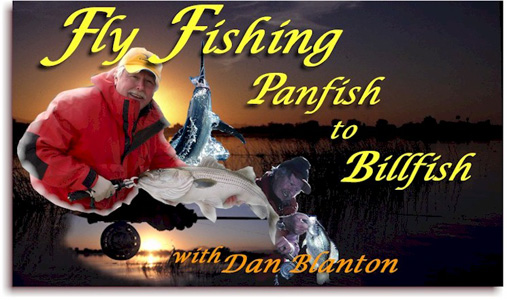
Indian River Lagoon Redfish on the Fly
By Captain Rodney Smith
The sweet fragrance of orange blossoms wafted on an offshore breeze flowing west over the Spartina grass shoreline of Merritt Island, Florida. The skinny water barely covering the sand and grass flats, was a mirror, reflecting an incredible seascape, providing us visual stimulation, a sense of tranquillity and a promise of a successful day.
I stopped our skiff a few hundred yards short of a long, very shallow sand bar which just the previous week was the dining room of a large clan of oversize redfish. Scanning the area, I quickly noticed from atop my poling platform, the first hint of this same school of mammoth reds about 75 yards ahead – a large area of “nervous water” giving them away. The sight of it was exciting enough to put me into my stalking mode…
Greg Poole stood still at the bow alert and ready with his 9 weight outfit in hand. The wakes of cruising red drum had him stoked! I had tantalized him before with stories of these big fish – redfish ranging from 30 to 50 pounds that cruised in water often less than two feet deep. Seeing is believing and Greg now strained his eyes to catch a glimpse of movement – a big red waking, or tailing up, rooting a morsel out of the fertile, grassy bottom.
Redfish are itinerate feeders, there one moment and gone the next. In skinny water they are almost as nervous as a bonefish in a school of barracuda and we stealthily approached the sand bar so not to flush them. Greg was hunkered over in a classical flats pose, trying to make himself invisible, his head snapping back and forth like an osprey seaching for it’s morning mullet. I pushed the skiff softly forward, just easing the pole into the sand when 10 to 15 redfish glided across the bottom just within Greg’s sight and range. Two hasty false casts and a quick release of the fly line and I watched Greg’s offering drop just ahead of their wakes and fading shadows. Two pulls on the weighted fly and a solid take, followed by a firm hookset, caused the shallow flat to erupt into a caldron of white water as the big red ripped the surface apart, shouldering for deep sanctuary. Greg had his hands full as backing poured from the reel, his rod humping and bucking – his face – total grin…
THE INDIAN RIVER LAGOON SYSTEM
The waters if the Indian River, Banana River and Mosquito Lagoons, along Florida’s central east coast (average depth of 2-3 feet), comprise one of the most diverse estuary systems in North America and perhaps the world. Once famous for it’s excellent spotted sea trout fishery, today these lagoons are rapidly gaining a reputation for having the world’s best shallow water fishing for giant redfish as well. The spotted sea trout’s size and population has declined over the last 20 years due to habitat degradation, loss of water quality and over-fishing. But the redfish are flourishing in the estuaries now and there are signs the trout are rebounding because of Florida’s net ban along with tighter size & bag limits.
FLORIDA’S REDFISH
Florida’s redfish had experienced a drastic decline in numbers before the FCA (now the Coastal Conservation Association of Florida) convinced he Marine Fisheries Commission, and the Florida Governor and his cabinet, to protect redfish from commercial harvest in state waters, back in the mid 1980s. A tight bag and size limit ( 1 fish per day between 18-27 inches) has reversed the decline and today redfish are flourishing, particularly in the Indian River Lagoon system.
Florida’s redfish , like those in Texas, South and North Carolina, are now becoming the king of the flats. Because of their wide distribution and the ability to sight cast to huge, tailing reds in skinny water, increasing numbers of fly and light tackle anglers are being attracted to this incredible flats angling. Today, fly-rodding for redfish is rivaling fly fishing for tarpon, bonefish and permit in terms of angler popularity.
SKINNY WATER TACTICS – FINDING AND APPROACHING FISH
The tactics used here along Florida’s Space Coast for hunting skinny-water redfish can be applied to other areas of Gulf and south Atlantic redfish waters as well. One strategy is to motor the outside edge of a flat with a watchful eye for waking redfish in the shallows. Once sighted, care must be taken to keep a safe distance in order not to spook them (200-400 hundred yards at least). Cut off your engine and then pole your boat to within casting distance. In order to avoid chasing a school of redfish (one of the worst things you can do), pre-judge the direction the fish are moving and lead them well, before you shut down your motor for a poling approach.
When stalking these giant flats redfish try to intercept the school’s path, keeping a watchful eye out for the lead fish. The actual location of the fish in relation to their wakes usually depends on the size of the school, the size of the fish and the speed the school is swimming. A fast moving school can be as much as ten yards ahead of their wake, while a school of browsing redfish may only be a few feet ahead of their wake. Bigger fish push larger wakes in shallow water making them easier to find under calm conditions. Occasionally, redfish schools will fin along the surface while cruising the outside edge of a flat in 2-3 feet of water. Always keep a vigilant eye peeled for what’s ahead of your boat while under way.
FLY FISHING FOR SKINNY WATER REDFISH
Fly fishing for these stout red fish is considerable sport, requiring plenty of skill. It’s easy enough to toss a live bait or half a blue crab to a school of cruising redfish, letting their piggish appetites and keen sense of smell direct them to the bait. Getting them to eat a fly is another story. The fly must be presented with deadly accuracy. Good casting skill is required. The difficult part of fly presentation is when the angler tries to lead the redfish by two feet, intercepting the redfish’s path, retrieving the fly right to it’s nose. This is a challenge considering these fish are most always moving and the wind can be screaming at you, 15 to 20 knots. It’s not that easy even on windless days.
TACKLING UP FOR REDFISH
fly rods for redfish should range from 8- to 9-weight depending upon the size of the fly and wind speed. An 8-weight rod will be comfortable most days, but if the wind is up, a 9- to 10-weight rod will perform best since the heavier fly line will carry larger flies, cutting the wind much easier.
Reels needn’t be expensive bluewater models, but they should have a smooth, top-end drag, and hold at least 250 yards of backing. The large arbor reels are nice, but standard spool designs work just fine.
Leader length and tippet size is not crucial unless the water is dead calm and the fish nervous. A three- or four-foot butt section with a three-foot class tippet of 20 pound, plus a 12-inch bite/abrasion leader will do in most cases unless you are looking for world records, of which there are plenty to be had if you’re so inclined. If you’re targeting world record reds, then you’ll need to rig with a standard IGFA Bimini Twist leader system, seven to nine feet overall, including butt section.
Top producing flies tend to be on the heavy side and a shorter leader makes casting less difficult. Quick fly presentation is critical! In most cases you want a fly that will drop quickly to bottom and then bounce along the grass for best results. Remember, redfish do 90% of their feeding with their noses glued to the lagoon’s grassy bottom. Fly colors do make a difference with gold, brown, black, or chartreuse attracting the most strikes. Opinions vary greatly when it comes to the best fly patterns for these redfish and there are a lot of good flies. For the larger redfish (20 to 40 pounds) I find that baitfish patterns work best. I prefer a fly that stinks quickly enough to get down and right in the face of a fast moving fish and flies like Clousers, Whistlers, Sar-Mul-Macs and other similar types have proven best for me.
The type of fly line you choose can also make a difference. For a faster presentation you may want to try a mono core line, also known as a “Slime Line”. A great one is marketed by Scientific Anglers and is called the Mastery clear Tarpon line. Because of their slick coating, Slime lines will reduce the number of false casts by a marked degree, which means a faster presentation. Remember, speed is everything since a school of redfish can sneak away with unbelievable quickness. A floating line works best in very skinny or grass congested water.
WORLD RECORDS FROM THE BANANA RIVER SYSTEM
In the spring of `94, two fly anglers, Don Leyden and his partner Art
Broadie, AKA, the “Black Ghost”, caught and released back to back world record redfish while fly fishing the Banana river lagoon. These fish were tailing in less then 2 feet of water and were caught on a Clouser type fly called the Last Chance. Don Leyden established the 16-pound, IGFA world record for red drum with a fish he caught that day. It weighed 38 pounds, a great fly-rod catch. However, it since has been eclipsed by a 43 pound redfish caught from the same area of the Banana River Lagoon.
These giant redfish live and breed in this lagoon system year round but the best fishing seems to be between March and mid-September because the weather is more dependable then. If you desire to catch a world record class redfish on a fly or light tackle, there’s no better place to do it than on the waters of the Indian River Lagoon system!
Captain Rodney Smith Guides fly anglers and light tackle enthusiasts year-round on the Indian River Lagoon system.For more information or to book a trip with Captain Rod, check out his listing on the Coast-to-Coast Guides page.
